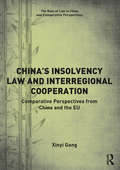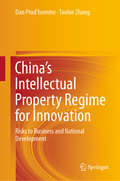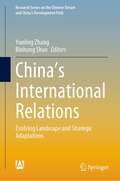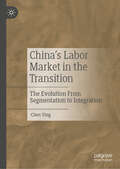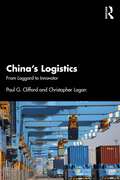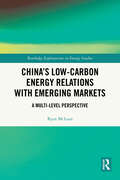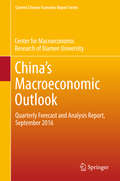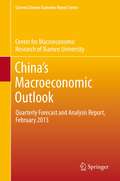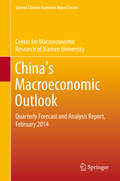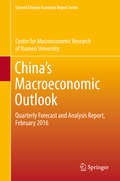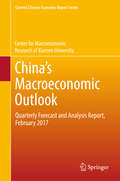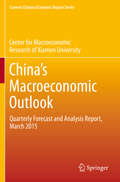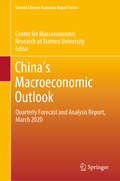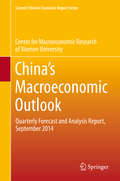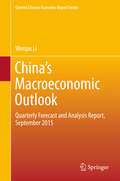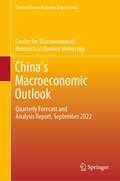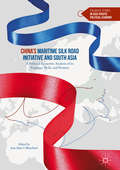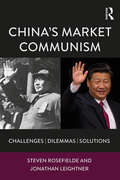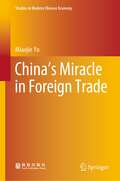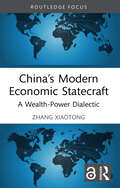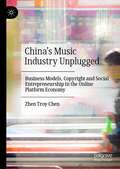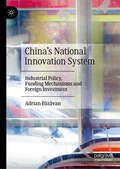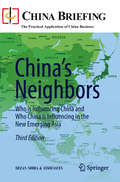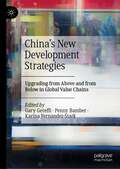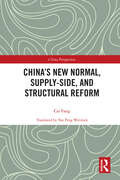- Table View
- List View
China’s Insolvency Law and Interregional Cooperation: Comparative Perspectives from China and the EU (The Rule of Law in China and Comparative Perspectives)
by Xinyi GongAs a result of resumption of sovereignty over Hong Kong and Macao as well as the uncertain relationship between the Mainland and Taiwan, China has become a country composed of peculiar political compounds, resulting in four independent jurisdictions. This makes inter-regional legal cooperation a complicated yet compelling topic. Divided into five parts, this book considers possible solutions to problems in China’s inter-regional cross-border insolvency cooperation. These solutions are developed on the basis of two groups of comparative studies, including comparison among the cross-border insolvency systems of the four independent jurisdictions in China and comparison between EU Insolvency Regulation and the UNCITRAL Model Law. The author discusses the advantages and disadvantages of the two systems and presents original recommendations for the way forward. The book will be a valuable resource for academics and policy makers in insolvency law, Asian law and comparative law.
China’s Intellectual Property Regime for Innovation: Risks to Business and National Development
by Dan Prud’homme Taolue ZhangThis book evaluates the risks that China’s intellectual property (IP) regime poses to innovation. China's IP regime has been heavily criticized as potentially stifling innovation. However, the country’s innovation capabilities have risen significantly and major reforms have recently been made to its IP regime. How risky, really, is China's IP regime for innovation? This book investigates this question at different units of analysis based on a multidisciplinary assessment involving law, management, economics, and political science. Specifically, it critically appraises China's substantive IP laws, measures for boosting patent quantity and quality, measures for transmitting and exploiting technological knowledge, new experimental IP measures, and China's systems for administering and enforcing IP. Practitioners and scholars from various backgrounds can benefit from the up-to-date analysis as well as the practical managerial tools provided, including risk assessment matrices for businesses and recommendations for institutional reform.
China’s International Relations: Evolving Landscape and Strategic Adaptations (Research Series on the Chinese Dream and China’s Development Path)
by Yunling Zhang Binhong ShaoThis book provides scholars in the English-speaking world with a window to understand China’s perspectives on diplomatic theories and policies. This book is a study of China’s diplomatic theories and Chinese foreign practice analysis. Along with the recent diplomatic strategy adjustments, diplomatic practices, and changes, it discusses China’s international relations with its neighbors, the USA, Japan, India, the Middle East, and SAARC, as well as the “One Road and One Belt” initiative.
China’s Labor Market in the Transition: The Evolution From Segmentation to Integration
by Chen YingThis book explores the dynamics of the Chinese labor market, the largest in the world. The sheer scale of rural laborers living in cities is the ultimate engine driving the fastest urbanization the world has ever seen. Today, the country faces a series of new challenges as it tries to address problems of unemployment and under-employment. These include population ageing, automation, the increasing use of AI on the factory floor and other workplaces and Chinese manufacturers’ move up the value chain. The book presents an empirically rich and analytically rigorous account of how these challenges might be met. It will be of interest to labor economists, scholars of Chinese manufacturing, and researchers of the Chinese economy.
China’s Logistics: From Laggard to Innovator
by Paul Clifford Christopher LoganExploring an underreported subject with global ramifications, this book sheds much-needed light on the rapid development of China’s logistics industry over the past several decades and puts it into historical context.Though still lagging behind global logistics leaders overall, China has invested heavily in logistics infrastructure and technology to become a vital link in global supply chains, and is forging ahead in e-commerce logistics. This timely book analyzes the key policies, infrastructure projects, technologies, and companies that have transformed China's domestic logistics capabilities and enabled it to become deeply intertwined with the worldwide supply chain. As the world enters a new era of geopolitics and confronts the possibility of US-China decoupling, it is more critical than ever to understand China's logistics system to navigate uncertain times—and with their decades of experience, these authors are the very best guides.Business leaders, policy makers, and logistics and supply chain professionals will benefit from this comprehensive and readable book’s insights into how and why China’s logistics system developed as it has, what that means for businesses and nations connected to China, and where we go from here.
China’s Low-Carbon Energy Relations with Emerging Markets: A Multi-Level Perspective (Routledge Explorations in Energy Studies)
by Ryan McLeanThis book explores China’s contemporary energy relations with emerging markets.Through the prisms of global low-carbon transition and power sector development, Ryan McLean utilises the multi-level perspective to build upon existing understandings of the Chinese renewables ‘revolution’ from a top-down interpretation. McLean presents an in-depth analysis of the external ramifications of China’s solar and wind dominance across the Global South in the areas of green technological trade, project construction, and regime financing. This research provides a convincing explanation for why Chinese coal incumbents have been proactive overseas in spite of the country’s clean energy dominance and Beijing’s climate commitments. Finally, the book argues that China’s low-carbon prowess has longer-term significance for the Global South, and in addition contributes to the rising debates over the geopolitics of renewable transition in a complex, multipolar world.This volume will be of great interest to students and scholars of Chinese energy policy and foreign relations, energy markets in the Global South, international politics, and the wider global energy transition field.
China’s Macroeconomic Outlook
by CMR of Xiamen UniversityThis book is a quarterly forecast and analysis report on the Chinese economy. It is published twice a year and presents ongoing results from the “China Quarterly Macroeconomic Model (CQMM),” a research project at the Center for Macroeconomic Research (CMR) at Xiamen University. Based on the CQMM model, the research team forecast major macroeconomic indicators for the next 8 quarters, including the rate of GDP growth, the CPI, fixed-asset investment, resident consumption and foreign trade. At the same time it focuses on simulation of current macroeconomic policies in China. In addition to helping readers understand China’s economic trend and policy guide, this book has three main goals: to help readers understand China’s economic performance; to forecast the main macroeconomic indicators for the next 8 quarters; and to simulate the effectiveness of macroeconomic policies.
China’s Macroeconomic Outlook: Quarterly Forecast and Analysis Report, February 2013 (Current Chinese Economic Report Series)
by CMR of Xiamen University StaffThe research team makes the following forecasts: First, in 2013 China's growth will remain stable and reach 8.23 percent, an increase of 0.43 percentage points compared with the previous year; even though there is inflation pressure resulting from global monetary easing, severe inflation in China is unlikely to happen, and the consumer price index (CPI) will remain at 3.11 percent. Second, the growth of imports and exports will rebound, but the trade surplus will decrease further. Finally, the share of investment in GDP will continue to be high in the short term as urbanization promotes the growth of fixed assets investment, though higher per capita incomes will result in high and steady consumption.
China’s Macroeconomic Outlook: Quarterly Forecast and Analysis Report, February 2014 (Current Chinese Economic Report Series)
by CMR of Xiamen UniversityThis book is a quarterly forecast and analysis report on the Chinese economy. It is published twice a year and presents ongoing result from the "China Quarterly Macroeconomic Model (CQMM)," a research project at the Center for Macroeconomic Research (CMR) at Xiamen University. Based on the CQMM model, the research team forecast major macroeconomic indicators for the next 8 quarters, including the rate of GDP growth, the CPI, fixed-asset investment, resident consumption and foreign trade. At the same time it focuses on simulation of current macroeconomic policies in China. In addition to helping readers understand China's economic trend and policy guide, this book has three main goals: to help readers understand China's economic performance; to forecast the main macroeconomic indicators for the next 8 quarters; and to simulate the effectiveness of macroeconomic policies.
China’s Macroeconomic Outlook: Quarterly Forecast and Analysis Report, February 2016 (Current Chinese Economic Report Series)
by Center for Macroeconomic Research of Xiamen UniversityThis book is a quarterly forecast and analysis report on the Chinese economy. It is published twice a year and presents ongoing results from the "China Quarterly Macroeconomic Model (CQMM)," a research project at the Center for Macroeconomic Research (CMR) at Xiamen University. Based on the CQMM model, the research team forecast major macroeconomic indicators for the next 8 quarters, including the rate of GDP growth, the CPI, fixed-asset investment, resident consumption and foreign trade. At the same time it focuses on simulation of current macroeconomic policies in China. In addition to helping readers understand China's economic trend and policy guide, this book has three main goals: to help readers understand China's economic performance; to forecast the main macroeconomic indicators for the next 8 quarters; and to simulate the effectiveness of macroeconomic policies.
China’s Macroeconomic Outlook: Quarterly Forecast and Analysis Report, February 2017 (Current Chinese Economic Report Series)
by Center for Macroeconomic Research of Xiamen UniversityThis book is a quarterly forecast and analysis report on the Chinese economy. It is published twice a year and presents ongoing results from the "China Quarterly Macroeconomic Model (CQMM)," a research project at the Center for Macroeconomic Research (CMR) at Xiamen University. Based on the CQMM, the research team forecasts China's major macroeconomic indicators for the next 8 quarters, including GDP growth rate, CPI, PPI, investment in fixed assets, household consumption, imports, exports, and foreign reserves. Moreover, it simulates different scenarios to study the effects of macroeconomic policy on the Chinese economy. In addition to helping readers to understand China's economic trends and policies, this book has three main goals: to help readers understand China's economic performance; to forecast the major macroeconomic indicators for the next 8 quarters; and to simulate the effectiveness of macroeconomic policy.
China’s Macroeconomic Outlook: Quarterly Forecast and Analysis Report, March 2015 (Current Chinese Economic Report Series)
by CMR of Xiamen UniversityThis book is a quarterly forecast and analysis report on the Chinese economy. It is published twice a year and presents ongoing result from the "China Quarterly Macroeconomic Model (CQMM)," a research project at the Center for Macroeconomic Research (CMR) at Xiamen University. Based on the CQMM model, the research team forecast major macroeconomic indicators for the next 8 quarters, including the rate of GDP growth, the CPI, fixed-asset investment, resident consumption and foreign trade. At the same time it focuses on simulation of current macroeconomic policies in China. In addition to helping readers understand China's economic trend and policy guide, this book has three main goals: to help readers understand China's economic performance; to forecast the main macroeconomic indicators for the next 8 quarters; and to simulate the effectiveness of macroeconomic policies.
China’s Macroeconomic Outlook: Quarterly Forecast and Analysis Report, March 2020 (Current Chinese Economic Report Series)
by Xiamen UniversityThis report is a partial result of the China’s Quarterly Macroeconometric Model (CQMM), a project developed and maintained by the Center for Macroeconomic Research (CMR) at Xiamen University. The CMR is one of the Key Research Institutes of Humanities and Social Sciences sponsored by the Ministry of Education of China, focusing on Chinese economic growth and macroeconomic policies. The CMR started to develop the CQMM for purpose of short-term forecast, policy analysis, and simulation in 2005.Based on the CQMM, the CMR with its partners hold press conferences to release forecasts for China’ major macroeconomic variables. Since July 2006, twenty-seven quarterly reports titled Chinese Macroeconomic Outlook have been presented and thirteen annual reports have been published.
China’s Macroeconomic Outlook: Quarterly Forecast and Analysis Report, September 2014 (Current Chinese Economic Report Series)
by CMR of Xiamen UniversityThis book is a quarterly forecast and analysis report on the Chinese economy. It is published twice a year and presents ongoing result from the "China Quarterly Macroeconomic Model (CQMM)," a research project at the Center for Macroeconomic Research (CMR) at Xiamen University. Based on the CQMM model, the research team forecast major macroeconomic indicators for the next 8 quarters, including the rate of GDP growth, the CPI, fixed-asset investment, resident consumption and foreign trade. At the same time it focuses on simulation of current macroeconomic policies in China. In addition to helping readers understand China's economic trend and policy guide, this book has three main goals: to help readers understand China's economic performance; to forecast the main macroeconomic indicators for the next 8 quarters; and to simulate the effectiveness of macroeconomic policies.
China’s Macroeconomic Outlook: Quarterly Forecast and Analysis Report, September 2015 (Current Chinese Economic Report Series)
by Wenpu LiThis book is a quarterly forecast and analysis report on the Chinese economy. It is published twice a year and presents ongoing results from the "China Quarterly Macroeconomic Model (CQMM)," a research project at the Center for Macroeconomic Research (CMR) at Xiamen University. Based on the CQMM model, the research team forecast major macroeconomic indicators for the next 8 quarters, including the rate of GDP growth, the CPI, fixed-asset investment, resident consumption and foreign trade. At the same time it focuses on simulation of current macroeconomic policies in China. In addition to helping readers understand China's economic trend and policy guide, this book has three main goals: to help readers understand China's economic performance; to forecast the main macroeconomic indicators for the next 8 quarters; and to simulate the effectiveness of macroeconomic policies.
China’s Macroeconomic Outlook: Quarterly Forecast and Analysis Report, September 2022 (Current Chinese Economic Report Series)
by Xiamen UniversityThis report is a partial result of China’s Quarterly Macroeconomic Model (CQMM), a project developed and maintained by the Center for Macroeconomic Research (CMR) at Xiamen University. The CMR is one of the Key Research Institutes of Humanities and Social Sciences sponsored by the Ministry of Education of China, focusing on China’s economic growth and macroeconomic policy. The CMR started to develop CQMM for purpose of short-term forecasting, policy analysis, and simulation in 2005.Based on CQMM, the CMR and its partners hold press conferences to release forecasts for China’ major macroeconomic variables. Since July 2006, thirty-three quarterly reports on China’s macroeconomic outlook have been presented.
China’s Maritime Silk Road Initiative and South Asia: A Political Economic Analysis of its Purposes, Perils, and Promise (Palgrave Studies in Asia-Pacific Political Economy)
by Jean-Marc F. BlanchardThis book brings together a diverse range of responses to China's Marine Silk Road Initiative, which proposes to redraw the map of Asia, particularly South Asia. China's 21st Century Maritime Silk Road Initiative (MSRI) is a massive scheme to connect wide swaths of East, Southeast, South, and West Asia through a dense web of interconnected hard and soft infrastructure involving ports, roads, logistics facilities, special industrial zones, and free trade and investment agreements. This book will be invaluable for students of Chinese foreign security and foreign economic policy, those interested in South Asia including Indian foreign security and economic policy as well as Indian relations with China, those attentive to international economic developments in East and South Asia, and those interested in the political and economic situation in specific MSRI participant countries such as Pakistan, Maldives, and Sri Lanka as well as their political and economic relations with China.
China’s Market Communism: Challenges, Dilemmas, Solutions
by Steven Rosefielde Jonathan LeightnerChina’s Market Communism guides readers step by step up the ladder of China’s reforms and transformational possibilities to a full understanding of Beijing’s communist and post-communist options by investigating the lessons that Xi can learn from Mao, Adam Smith and inclusive economic theory. The book sharply distinguishes what can be immediately accomplished from the road that must be traversed to better futures.
China’s Miracle in Foreign Trade (Studies in Modern Chinese Economy)
by Miaojie YuThis book mainly focuses on the miracle of China’s foreign trade in the past 40 years from five perspectives: first, it briefly reviews the import substitution strategy China adopted before its opening-up; second, it analyzes the export-oriented strategy that contributes a lot to China’s economic growth since 1980s; third, it discusses the impacts of trade liberalization and China’s participation in WTO on Chinese firms; forth, it addresses the deepening opening-up in the context of global financial crisis; last, it provides policy advice on China’s newly conducted all-around opening-up strategy. By dividing China’s opening-up into five stages, this book offers a comprehensive discussion to understand and analyze the reason, performance and challenge of China’s economic growth from the perspective of foreign trade.
China’s Modern Economic Statecraft: A Wealth-Power Dialectic (Routledge Studies in the Modern World Economy)
by Zhang XiaotongThis compelling exploration delves into President Xi Jinping's ambitious efforts to restore China to its historical role as a global leader through innovative economic means. Bridging the philosophies of Mao Zedong and Deng Xiaoping, Xi's approach is a unique synthesis of Marxist-Developmentalist ideas, aiming to convert China's accumulated national wealth into great power status.At the heart of this narrative is a wealth-power dialectic, shaping the performance and challenges of China's modern economic statecraft. The book chronicles the optimism of Xi's first term, the overreach and subsequent retrenchment of his second, all set against the backdrop of a slowing domestic economy and intensifying strategic competition with the United States. Despite these hurdles, the Chinese government continues to expand its arsenal of economic tools and initiatives, showcasing resilience and adaptability.This book offers an insightful look into how Xi Jinping's tenure might be remembered as a pinnacle in China's Marxist-Developmentalist economic history. This book is a must-read for anyone interested in understanding the intricate strategies behind China's quest for global preeminence.The Open Access version of this book, available at http://www.taylorfrancis.com, has been made available under a Creative Commons [Attribution-Non Commercial-No Derivatives (CC-BY-NC-ND)] 4.0 license.
China’s Music Industry Unplugged: Business Models, Copyright and Social Entrepreneurship in the Online Platform Economy
by Zhen Troy ChenThis research book is the first of its kind to conduct an interdisciplinary research on the recent and dramatic developments in China’s music industries with a particular focus on business models, copyright protection, and artist compensation. The monograph explores and discusses proper business models through which revenue can be generated and maintained in a changing copyright climate and transforming business environment. It also discusses how musicians can be fairly compensated in the online platform economy informed by social entrepreneurship. This book is distinctive in the sense that it explores the intersection of cultural and creative industries, legal studies, business studies, and new media. It uses a qualitative and mixed-method approach to study business innovations and institutions in the making in the second largest economy which is also gaining cultural and political significance around the world.
China’s National Innovation System: Industrial Policy, Funding Mechanisms and Foreign Investment
by Adrian BăzăvanChina abruptly became the second largest economy and, at the same time, the second largest R&D spender in the world, aiming openly to become an innovation powerhouse that holds the edge in critical technologies. The significant consequences on global trade flows, international security, governance and economy are increasingly drawing the attention of policymakers, academics, and industry leaders worldwide. The study highlights the main characteristics and trends of the national innovation system in China, as well as its strengths, challenges, and prospects. It examines in detail public policies, funding mechanisms for innovation, inbound and outbound FDI, IPR mechanisms, public perception towards technology, priority industries, and other factors. It thus identifies the main innovative actors of the system, including government, industry and research institutions, highlighting the patterns of interaction among them. The findings are showcased in a focused case study on the AI industry and further serve to advance policy recommendations for the EU. Traditionally, China has made more effort and has achieved better results in understanding and learning from ‘the West’. It is now vital for other countries to better understand China.
China’s Neighbors: Who is Influencing China and Who China is Influencing in the New Emerging Asia (China Briefing)
by Dezan Shira AssociatesDesigned with the foreign investor in mind, this guide presents region and city-specific intelligence available through few other English sources. Its pages overview the region from a business standpoint, examine the economy of the region's provinces and prominent cities in depth, and introduce the basics of establishing a business in the region. With detailed economic indicators and primary research largely from Chinese government and news sources, this guide is an accessible and engaging compilation of the practical information you need for doing business in the region. This is part of a five book business guide series: the Yangtze River Delta, Beijing and Northeast China, South China and the Greater Pearl River Delta, Central China and West China.
China’s New Development Strategies: Upgrading from Above and from Below in Global Value Chains
by Gary Gereffi Penny Bamber Karina Fernandez-StarkThis book examines China’s new development policies, which seek to reposition China from export platform for a diverse array of low-cost consumer goods to technological leader in sectors linked to advanced manufacturing, artificial intelligence, electric vehicles, e-commerce, and new internet-related production networks oriented to China’s large domestic market. Focusing on the post-2010 period, the book shows how China’s central government programs and reforms (“upgrading from above”) are coupled with a wide variety of local government policies, firm strategies, and domestic economy shifts (“upgrading from below”) that link China’s top-down programs into industrial growth on the ground. Placing China’s current development push within a global value chain (GVC) context shows how Chinese development strategies and the global economy remain intertwined. This volume brings together international GVC experts and China-based researchers who have carried out detailed fieldwork and industry specific quantitative analyses of GVCs and development with important implications for policymakers in both developed and developing economies.
China’s New Normal, Supply-side, and Structural Reform (China Perspectives)
by Cai FangChina’s continuous, rapid economic growth since the Reform and Opening up of the country in the early 1980s has been praised as a miracle of the world economy. However, since 2012, the rate of growth has slowed down, rendering some people pessimistic about the country’s economic prospects. This title is a collection of a leading Chinese economists’ views on China’s economic growth and structural reform. The author argues that China’s economy has entered “the new normal”, meaning that slowed growth rate is not a cyclical phenomenon but a change in the stage of economic development. Therefore, there is a need to enact supply-side structural reforms, such as improved efficiency of resource reallocation, while shifting the mode of development from one of inputs to innovation. In addition, the author discusses the five major concepts of development proposed for the “13th Five-Year Plan”, as well as some critical topics related to supply-side structural reform, such as agricultural development, labor employment, and product quality. Scholars and students of macroeconomics, development economics, and the Chinese economy will find this book to be essential reading.
